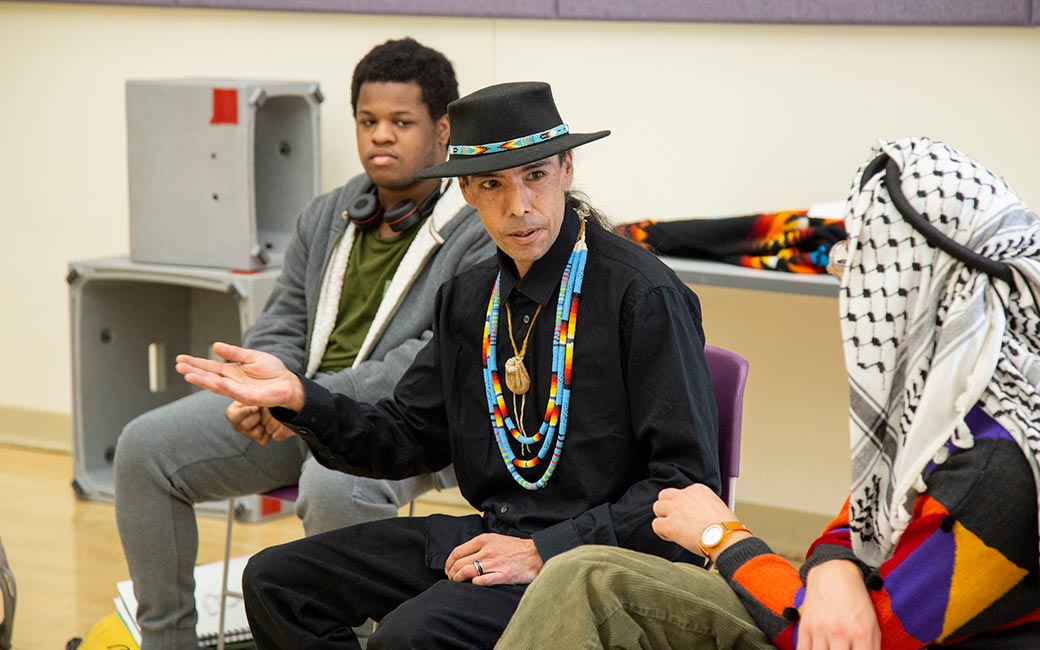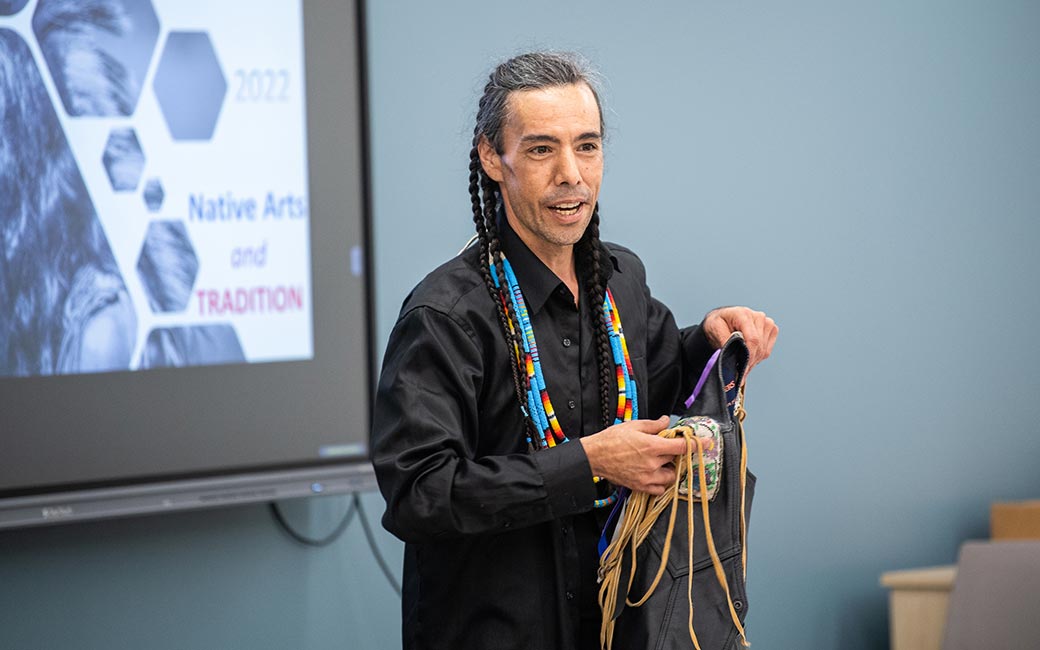Visiting artists share Native culture, tradition
Rosenberg Distinguished Artists Buck Hitswithastick, Rose Gurule spend week in residency with theatre arts, dance students
By Rebecca Kirkman on December 12, 2022

During an intensive week in mid-October, members of the Towson University community learned from visiting artists Buck Hitswithastick and Rose Gurule, members of the Bitterroot Salish tribe from the Confederated Salish and Kootenai Tribes of the Flathead Nation in Montana.
Both are artists and leaders in their community and have a rich history of sharing the knowledge of Indigenous communities. A descendent of the Dog Soldiers of the Bitterroot Salish people—who act as delegates, liaisons and protectors for the tribe—Hitswithastick continues the tradition by sharing Native arts and culture. Gurule’s great aunt, Agnes Vanderburg, was an important elder who created a space to share her culture with the world. Gurule, like Vanderburg, is culture keeper, teacher, organizer and a master at beading and many other Native American crafts.
Their TU residency was made possible by the Rosenberg Distinguished Artist Endowment, a fund established in 1998 by The Henry and Ruth Blaustein Rosenberg Foundation through a multiyear commitment of $200,000. The fund supports artist residencies in theatre arts and dance that foster opportunities for in-depth learning and substantive artist–student interaction.
During the residency, Hitswithastick and Gurule worked with College of Fine Arts & Communication students in theatre arts classes, including Cultural Diversity in Contemporary Theatre, Theatre for Social Change and Ensemble Theatre Lab and dance courses, including Modern Dance and Senior Seminar.
Additionally, the artists offered an open workshop to the campus community in collaboration with the Office of Inclusion & Institutional Equity and Center for Student Diversity.
“We’re at a critical point in history where Native voices need to be heard,” Hitswithastick said during his presentation, where he shared his tribe’s history, culture and traditional regalia. “We’re still here, we’re still alive and we haven’t changed.”

Hitswithastick came to TU by way of Tavia LaFollette, associate professor of theatre arts, who is collaborating with the artist to hold a summer program for TU students in Montana through the Study Abroad & Away Office.
TU Native America: A Pilgrimage in Reciprocity in Montana gives students a unique opportunity to examine the art and social practice of performance, ritual and culture through an ecological and interdisciplinary lens while staying on the Flathead Reservation of the Confederated Salish and Kootenai Tribes. Applications for the summer 2023 program are accepted on a rolling basis and due by March 15.
The program is inspired partly by LaFollette’s own experience, when as a teenager she visited the Agnes Vanderburg Culture Camp in Montana. Since the 1970s, the camp has shared Native arts and culture with visitors from across the world.
As an artist, LaFollette examines performance as a social practice.
“There’s a social aspect to the work that I do,” she says. “We’re all performing all the time—whether it’s cultural performance or performance as a member of a community.”
The partnership with Hitswithastick grew out of LaFollette’s ongoing project “Sites of Passage,” which aims to build global interchanges for the migration of ideas across political and cultural borders. While on sabbatical during the COVID-19 pandemic, she took a road trip to Montana with her family to revisit the culture camp, reconnect with Hitswithastick and research the study away program.
Taught by LaFollette and Native elder Rachel Bowers, the program will teach students guardianship, conservation and reciprocity while reflecting on the tribes' ancestors’ sacrifices. Embedded in ritual, storytelling and oral history, each student will have a chance to work directly under an elder/mentor.
“We designed the program like the culture camp, so there are different stations where students learn from elders—basket weaving, beading, medicines, tanning a hide, flute making. Then they can choose and finish a project and at the end share about the process,” LaFollette says. Before the trip, students will prepare with background readings and films then will visit museums and historic sites in Montana to learn about the culture.
“We want the students to have a really deep understanding of the context of the reservation they are visiting,” LaFollette says.